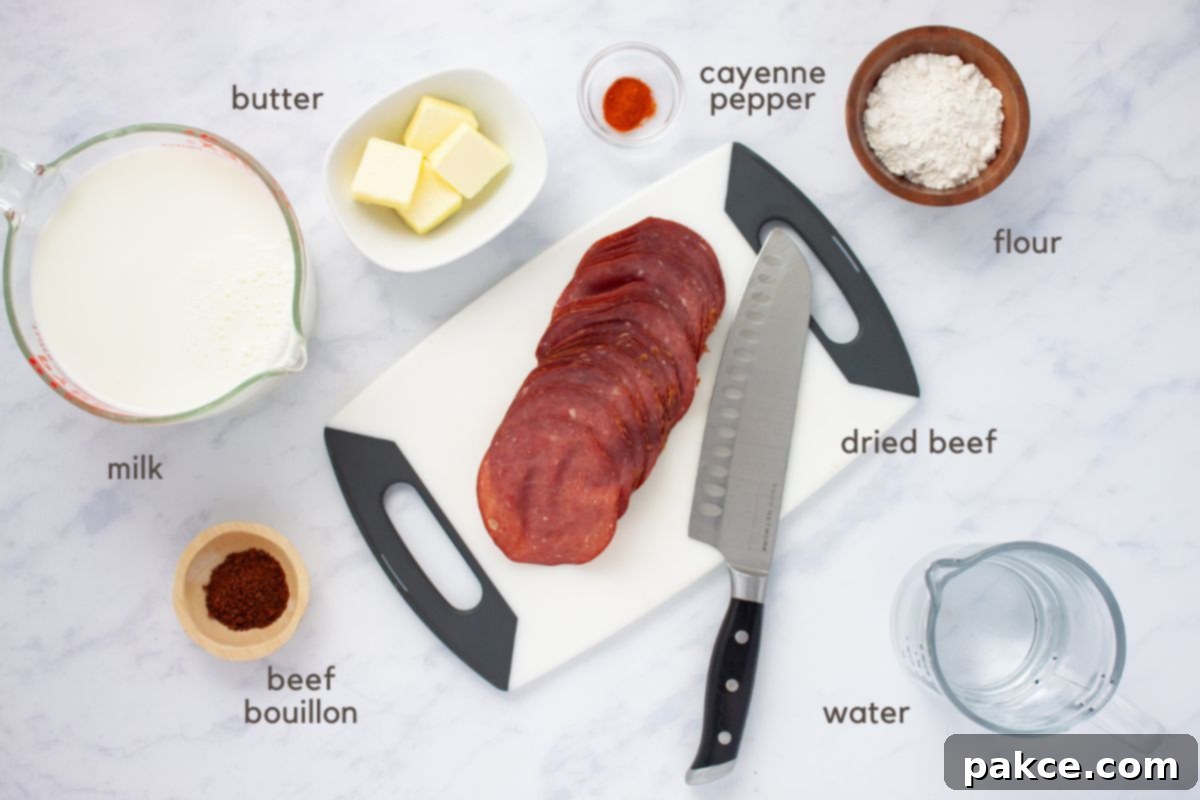The Ultimate Creamy Chipped Beef Gravy (SOS) Recipe: A Hearty Comfort Food Classic
Step into a world of culinary nostalgia with a truly timeless American comfort food: Creamy Chipped Beef Gravy, affectionately known to many as “SOS.” This classic dish offers a hearty, homey, and deeply satisfying experience that instantly transports you back to simpler times. Our expertly crafted chipped beef gravy recipe stands out by enhancing the rich beef flavor throughout its creamy, homemade base, thanks to the perfect touch of beef bouillon. Whether you serve it over fluffy biscuits, crispy toast, or soft rolls, chipped beef with gravy is a versatile and beloved option, especially for those delightful breakfast-for-dinner evenings.
Beyond its delicious taste, this recipe is incredibly practical. Both dried beef and beef bouillon are pantry staples with long shelf lives, making them ideal ingredients to keep on hand for unexpected dinner emergencies. You’ll likely find that you can conjure up this savory gravy magic with just a few common groceries already in your fridge and pantry, proving that true comfort is always within reach.
This detailed guide will walk you through everything you need to know to create the perfect batch of homemade chipped beef gravy. From understanding each ingredient’s role to mastering the art of a lump-free roux, we’ve got you covered. Get ready to transform simple dried beef into a rich, creamy, and unforgettable meal that will become a cherished staple in your household.
Add Salt & Serve may earn affiliate commissions from purchases made using links on this page.

[feast_advanced_jump_to]
Watch How to Make Creamy Chipped Beef Gravy (Video Guide)
Essential Ingredients for Perfect Chipped Beef Gravy
Crafting the perfect creamy chipped beef gravy starts with a selection of simple yet powerful ingredients. Each component plays a crucial role in building the deep flavor and silky-smooth texture that makes this dish a true standout. Here’s a closer look at what you’ll need and why:

- Butter: This is the foundation of our roux, creating the creamy base for the gravy. While I typically use salted butter for most cooking, consider using unsalted butter in this recipe. Dried beef is inherently salty, and beef bouillon adds another layer of sodium, so unsalted butter helps you control the overall saltiness of your final dish more precisely.
- All-purpose flour: A simple yet essential thickening agent. The flour, when cooked with butter, forms the roux that gives our gravy its luscious, thick consistency. There’s no special trick here, just standard all-purpose flour, crucial for achieving that desired gravy texture.
- Milk: The liquid base for the gravy. Whole milk will yield the richest, creamiest gravy, delivering that classic comfort food experience. However, you can use 2% or even skim milk for a lighter version, though the texture might be slightly less decadent and the flavor less rich.
- Beef bouillon: This is a secret weapon for intensifying the beef flavor without needing to cook down beef broth for hours. I prefer beef bouillon granules because they dissolve effortlessly, ensuring a smooth gravy. If you only have bouillon cubes, remember that one cube typically equals one teaspoon of granules; just crush it first to help it dissolve quicker. This addition truly makes the beef gravy shine.
- Cayenne pepper: For a touch of warmth and subtle spice. A pinch is usually enough to elevate the flavor profile without making it overtly hot. If you prefer more heat, feel free to increase the amount, or if you’d like a different kind of kick, a few dashes of your favorite pepper sauce (like Tabasco) can be substituted. For a completely mild gravy, you can omit the cayenne altogether.
- Dried beef: The star ingredient! This cured, thinly sliced beef is what makes “chipped beef gravy” unique. Brands like Armour and Hormel are commonly available in jars and can typically be found in the canned meat aisle of most grocery stores. It’s crucial to soak it before use to reduce its significant salt content.
- Water: Specifically used for soaking the dried beef. This step is vital for making the gravy palatable by drawing out excess sodium from the cured beef. Don’t skip it!
For exact quantities and detailed measurements, please refer to the complete recipe card below.
Step-by-Step Guide: How to Make Creamy Chipped Beef Gravy
Creating this delicious chipped beef gravy is a straightforward process, but a few key techniques will ensure a perfectly smooth and flavorful outcome every time. Follow these steps for a gravy that’s rich, creamy, and utterly irresistible.

1. Prepare the Dried Beef
Before you even think about the gravy, it’s essential to prepare the dried beef. Place the thinly sliced dried beef in a bowl and cover it completely with fresh water. Allow it to soak for about 10-15 minutes. This crucial step significantly reduces the high salt content that cured dried beef typically has, preventing your gravy from being overwhelmingly salty. For particularly salty brands, you might even consider draining and replacing the water once or twice, or extending the soaking time up to 30 minutes. (1)
Once soaked, thoroughly drain the beef and discard the water. Then, transfer the beef to a cutting board and chop it into small, bite-sized pieces. Aim for uniform pieces, as this ensures that the beef is evenly distributed throughout your gravy and is easy to eat with each spoonful. Set the prepared beef aside. (2)
2. Create the Roux (White Sauce Base)
The secret to a smooth, lump-free gravy lies in a well-made roux. Begin by melting the butter in a large skillet over medium to medium-high heat. Ensure the butter is fully melted and bubbling gently but is not browning. (3)
Once the butter is perfectly melted, gradually add the all-purpose flour to the skillet (4). Immediately use a whisk to stir the mixture constantly. You want to cook this butter-flour paste, known as a roux, for about one minute. It should be bubbly and thick, but it’s important not to let it brown at all. Cooking the roux helps eliminate the raw flour taste and ensures your gravy will have a smooth, silky texture, forming the perfect foundation for your creamy chipped beef gravy.

3. Build the Creamy Gravy Base
Once your roux is cooked and still bubbly, it’s time to add the milk. Gradually pour in the milk, a little at a time, while continuously whisking to create a smooth white sauce. This gradual addition and constant, vigorous whisking are absolutely crucial to prevent lumps from forming. Continue to stir frequently as the mixture gently comes to a simmer. You’ll notice it starting to thicken as it heats. (6)
Next, add the beef bouillon granules and a pinch of cayenne pepper to the simmering white sauce. The bouillon will dissolve and infuse the gravy with an even richer beef flavor, complementing the dried beef beautifully and deepening the umami notes. The cayenne pepper adds a subtle kick, balancing the richness of the gravy without making it overtly spicy. Continue to simmer over medium-low heat, stirring frequently, until the gravy thickens to your desired consistency. Remember, it will thicken slightly more as it cools. (7)
4. Combine and Serve
Finally, stir in the chopped dried beef into the thickened creamy gravy (8). Continue heating over medium-low heat, stirring occasionally, until the dried beef is thoroughly heated through. This ensures all the flavors meld together perfectly and the beef is warm throughout, ready to be enjoyed.

Serve this comforting creamed chipped beef generously over warm, flaky biscuits, crunchy toast, or soft dinner rolls. Dried beef gravy over biscuits makes for an incredibly satisfying and hearty breakfast or dinner. To complete the meal, consider pairing it with fresh fruit – perhaps juicy orange or clementine sections in winter, or a vibrant mix of seasonal local fruit and berries any other time of year. A simple side salad can also cut through the richness beautifully, offering a refreshing contrast to the savory gravy.

Customizing Your Chipped Beef Gravy: Substitutions & Variations
One of the best things about comfort food recipes like chipped beef gravy is how easily they can be adapted to suit your taste preferences or dietary needs. Here are some ideas to make this creamy gravy truly your own:
- Spicy or mild: The cayenne pepper adds a gentle warmth, but you’re in control. Increase the amount for a bolder kick, decrease it for just a hint of spice, or omit it entirely if you prefer a completely mild gravy. For an alternative heat, a few dashes of your favorite hot sauce (like Tabasco or a dash of smoked paprika) can also be a wonderful addition, bringing a different layer of flavor and heat.
- Lower sodium options: Since dried beef and bouillon are quite salty, managing sodium content is important for some. You can significantly decrease the sodium by omitting the beef bouillon granules altogether, or by opting for a low-sodium bouillon product. Additionally, soaking the dried beef for a longer period – even overnight in the refrigerator with a couple of changes of water – will extract more salt, making the final dish healthier without sacrificing flavor. Always be sure to taste and adjust seasoning only after all ingredients are combined.
- Swap the protein for different gravies: This versatile gravy base can be used to create other delicious breakfast or dinner gravies:
- Breakfast Sausage Gravy: Simply brown about 1/2 pound of breakfast sausage (pork or turkey) in the skillet, drain any excess fat (leaving a tablespoon or two), then proceed with making the roux and gravy as directed, omitting the dried beef and beef bouillon.
- Hard-boiled Egg Gravy: For a unique twist, chop several hard-boiled eggs and stir them into the finished white sauce. In this version, you would omit the beef bouillon entirely or use a little chicken bouillon or vegetable bouillon for a different flavor profile.
- Leftover Roast Beef Gravy: If you have leftover cooked roast beef, thinly slice or shred it and add it to the gravy for an even richer beef experience that’s perfect over mashed potatoes.
- Dairy-free alternative: For those avoiding dairy, you can substitute plant-based milk (like unsweetened almond milk, oat milk, or soy milk) and a vegan butter alternative. The gravy may have a slightly different flavor and consistency, but it will still be creamy and delicious. Be sure to choose plain, unsweetened varieties.
- Gluten-free version: Easily make this gravy gluten-free by swapping the all-purpose flour for a gluten-free all-purpose flour blend (ensure it contains xanthan gum for best results, or add a pinch) or cornstarch. If using cornstarch, create a slurry with a small amount of cold milk before adding it to the hot gravy to avoid lumps, then simmer until thickened. The ratio might need slight adjustment.
Storage and Reheating Tips for Chipped Beef Gravy
Proper storage is key to enjoying your delicious chipped beef gravy for days to come. Store any leftovers in an airtight container in the refrigerator for up to 4 days. This ensures its freshness and prevents spoilage, allowing you to enjoy this comforting meal multiple times.
When reheating, it’s best to do so gently on the stovetop over low to medium-low heat, stirring frequently. Cream sauces tend to thicken significantly when chilled, so you may need to add a splash or two of milk or water while reheating to return it to your desired creamy consistency. Avoid high heat, as it can cause the sauce to break, curdle, or become grainy. Stirring frequently will help maintain its smooth texture.
It’s important to note that cream sauces, including chipped beef gravy, generally do not stand up well to freezing. The freezing and thawing process can cause the dairy components to separate, resulting in a grainy or unappealing texture. For the best quality and taste, enjoy this gravy fresh or within the recommended refrigerated storage time.
Expert Tips for the Best Creamy Chipped Beef Gravy
Achieving a restaurant-quality chipped beef gravy at home is simpler than you think with these expert tips:
- Mastering the Roux for a Smooth Gravy: The key to a silky, lump-free cream sauce for your gravy is in the roux. After the butter melts (but well before it starts to brown), add the flour. Whisk continuously over medium to medium-high heat for at least one minute. You’re looking for a bubbly simmer without any browning – this cooks out the raw flour taste and prevents a raw, starchy flavor. Once cooked, gradually add the milk, whisking vigorously. Continue whisking frequently over medium to medium-high heat until the creamy white sauce thickens to the desired consistency. Patience and constant stirring are your best friends here to prevent lumps and ensure a perfectly smooth gravy.
- Easily Adjusting Gravy Quantity: When making gravy, you can easily adjust the amount by keeping a simple proportion in mind. For every cup of milk you want to use, use 1 tablespoon of butter and 1 tablespoon of all-purpose flour. This 1:1:1 ratio for butter, flour, and milk (per cup of milk) is a foolproof way to scale the recipe up or down without compromising consistency or flavor.
- Perfect Pairings: While classic over toast, this comforting chipped beef gravy shines brightest when served over our 3-Ingredient Buttermilk Biscuits. They are incredibly easy to make and boast just the right flaky, soft consistency to soak up every drop of this delicious gravy. It’s a match made in comfort food heaven! You can also serve it over creamy mashed potatoes for a hearty dinner, crispy hash browns for breakfast, or even over grits for a delightful Southern twist. A sprinkle of fresh parsley or chives can add a touch of color and freshness.
Frequently Asked Questions About Chipped Beef Gravy
Why is Chipped Beef Gravy called SOS?
Chipped Beef Gravy has a long and storied history, particularly within military culture, dating back to at least World War I. Troops in mess halls, where it was a common and economical meal served over toast (often referred to as “shingles”), famously nicknamed it “Shit on a Shingle” (SOS). Despite its less-than-appetizing name, the dish became a staple for its heartiness, affordability, and ability to provide much-needed calories to soldiers. If you’re curious to delve deeper into the fascinating history of this military classic, including why soldiers had such a love-hate relationship with it, you can find excellent resources like Chipped Beef: The History of the Meal Soldiers Love To Hate.
Is chipped beef the same as dried beef?
Yes, “chipped beef” is indeed synonymous with “dried beef.” The terms are used interchangeably to refer to the same product. Chipped beef is essentially a thinly sliced, air-dried or partially dried beef that has been cured and salted. This traditional curing process gives it a distinct savory and intensely salty flavor, as well as its characteristic firm yet pliable texture. It’s typically sold in jars or vacuum-sealed packages and is a shelf-stable product, making it a convenient ingredient to keep on hand for a variety of dishes, especially creamy gravies after proper soaking.
How do I prevent lumps in my gravy?
Preventing lumps in your chipped beef gravy is all about technique, specifically when making the roux and adding the milk. First, ensure your roux (butter and flour mixture) is thoroughly cooked for at least one minute, stirring constantly, before adding any liquid. This helps the flour absorb the fat evenly. Second, add the milk gradually, a little at a time, while continuously whisking the mixture. Start with a small amount of milk to create a thick paste, then slowly incorporate the rest, maintaining constant whisking. This gradual emulsification prevents the flour from clumping and ensures a silky-smooth gravy. Using warm milk (not hot, just slightly warmed) can also help in achieving a smoother consistency more quickly.
What’s the best type of milk for this gravy?
For the richest, most decadent, and truly authentic creamy chipped beef gravy, whole milk is highly recommended. Its higher fat content contributes significantly to a thicker, smoother, and more luxurious texture, enhancing the overall comfort food experience. If you prefer a slightly lighter gravy, 2% milk can be used, but be aware that the final product might be a little less thick and creamy. Skim milk is generally not recommended as it can result in a thinner, less flavorful gravy with a watery or less satisfying consistency. Stick with whole milk for the best possible results and that classic creamy taste!
Can I use fresh beef instead of dried beef?
While you certainly can make a beef gravy with fresh beef, it wouldn’t technically be “chipped beef gravy” in the traditional sense. The unique flavor and texture of chipped beef gravy come from the cured, thinly sliced, and rehydrated dried beef. Fresh beef would require browning and simmering to develop flavor and tenderness, and it would yield a different, though still delicious, outcome. If you’re looking for a similar creamy beef gravy but with fresh meat, consider using finely ground beef or very thinly sliced, cooked roast beef. Just remember to adjust seasonings and cooking times accordingly, as fresh beef won’t have the same inherent saltiness or cured flavor profile.
Full Chipped Beef Gravy Recipe

Chipped Beef Gravy
Add to Shopping ListGo to Shopping List
